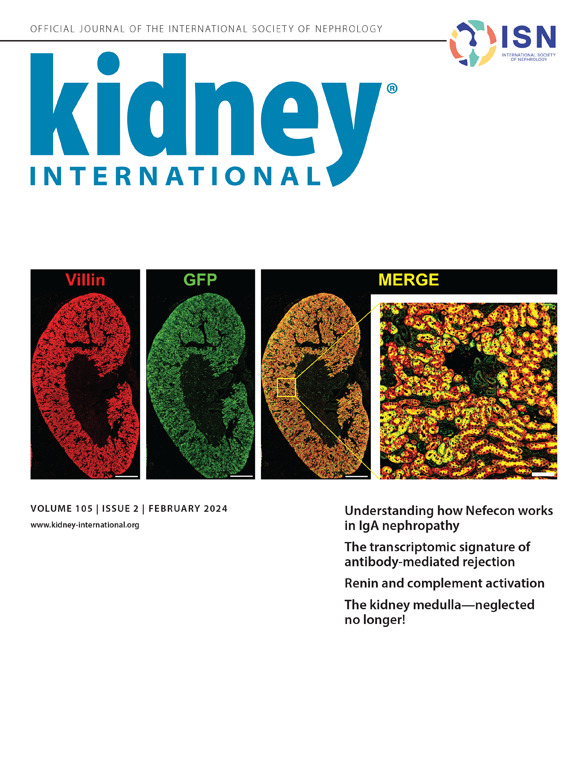编码磷酸钠转运体 NPT 2a 和 2c 的 SLC34A1 和 SLC34A3 致病变体携带者的表现和预后。
IF 14.8
1区 医学
Q1 UROLOGY & NEPHROLOGY
引用次数: 0
摘要
编码磷酸钠转运体 2a 和 2c 的 SLC34A1 和 SLC34A3 的致病变体是导致磷酸盐缺乏症的罕见原因。由于有关表现和预后的数据很少,我们通过在线问卷调查和欧洲专业组织的支持收集了临床、生化和遗传数据。我们对来自 17 个国家 90 个家庭的 113 名患者(86% 为儿童)进行了分析,这些患者的 SLC34A1 或 SLC34A3 存在致病变异或可能存在致病变异,中位随访时间为三年。双叶SLC34A1变异携带者在婴儿期表现为多尿、发育不良、呕吐、便秘、高钙血症和肾钙化症,而双叶SLC34A3携带者在儿童期甚至成年期表现为佝偻病/骨软化症和/或骨质疏松症/骨质疏松症、低磷血症,较少见的是肾钙化症,而肾结石的发病率相当。与普通人群相比,成人双倍拷贝 SLC34A3 携带者的慢性肾病(CKD)患病率增加了六倍。所有双叶变异携带者都有共同的生化模式,包括 1,25(OH)2D 和碱性磷酸酶水平升高、甲状旁腺激素(PTH)抑制和高钙尿症。杂合子携带者表现出类似但不太明显的表型。在双拷贝 SLC34A1 携带者中,婴儿期后临床特征有所减弱,与治疗无关。55%的患者接受了磷酸盐治疗,中位持续时间为两年,结果是碱性磷酸酶和高钙尿症明显降低(尽管未恢复正常),但PTH水平升高,而1,25(OH)2D水平仍然升高。因此,我们的研究表明,双拷贝 SLC34A1 和 SLC34A3 携带者表现出不同的表型,尽管有重叠,但后者成年后患慢性肾脏病的风险增加。磷酸盐治疗可能会促进肾脏磷酸盐流失,并通过增加 PTH 的产生来促进 1,25(OH)2D 的合成。本文章由计算机程序翻译,如有差异,请以英文原文为准。

Presentation and outcome in carriers of pathogenic variants in SLC34A1 and SLC34A3 encoding sodium-phosphate transporter NPT 2a and 2c
Pathogenic variants in SLC34A1 and SLC34A3 encoding sodium-phosphate transporter 2a and 2c are rare causes of phosphate wasting. Since data on presentation and outcomes are scarce, we collected clinical, biochemical and genetic data via an online questionnaire and the support of European professional organizations. One hundred thirteen patients (86% children) from 90 families and 17 countries with pathogenic or likely pathogenic variants in SLC34A1 or SLC34A3 and a median follow-up of three years were analyzed. Biallelic SLC34A1 variant carriers showed polyuria, failure to thrive, vomiting, constipation, hypercalcemia and nephrocalcinosis in infancy, while biallelic SLC34A3 carriers presented in childhood or even adulthood with rickets/osteomalacia and/or osteopenia/osteoporosis, hypophosphatemia and, less frequently, nephrocalcinosis, while the prevalences of kidney stones were comparable. Adult biallelic SLC34A3 carriers had a six-fold increase chronic kidney disease (CKD) prevalence compared to the general population. All biallelic variant carriers shared a common biochemical pattern including elevated 1,25(OH)2D and alkaline phosphatase levels, suppressed parathyroid hormone (PTH), and hypercalciuria. Heterozygous carriers showed similar but less pronounced phenotypes. In biallelic SLC34A1 carriers, an attenuation of clinical features was observed after infancy, independent of treatment. Phosphate treatment was given in 55% of patients, median duration two years, and resulted in significant reduction, although not normalization, of alkaline phosphatase and of hypercalciuria but an increase in PTH levels, while 1,25(OH)2D levels remained elevated. Thus, our study indicates that biallelic SLC34A1 and SLC34A3 carriers show distinct, albeit overlapping phenotypes, with the latter having an increased risk of CKD in adulthood. Phosphate treatment may promote kidney phosphate loss and enhance 1,25(OH)2D synthesis via increased PTH production.
求助全文
通过发布文献求助,成功后即可免费获取论文全文。
去求助
来源期刊

Kidney international
医学-泌尿学与肾脏学
CiteScore
23.30
自引率
3.10%
发文量
490
审稿时长
3-6 weeks
期刊介绍:
Kidney International (KI), the official journal of the International Society of Nephrology, is led by Dr. Pierre Ronco (Paris, France) and stands as one of nephrology's most cited and esteemed publications worldwide.
KI provides exceptional benefits for both readers and authors, featuring highly cited original articles, focused reviews, cutting-edge imaging techniques, and lively discussions on controversial topics.
The journal is dedicated to kidney research, serving researchers, clinical investigators, and practicing nephrologists.
 求助内容:
求助内容: 应助结果提醒方式:
应助结果提醒方式:


